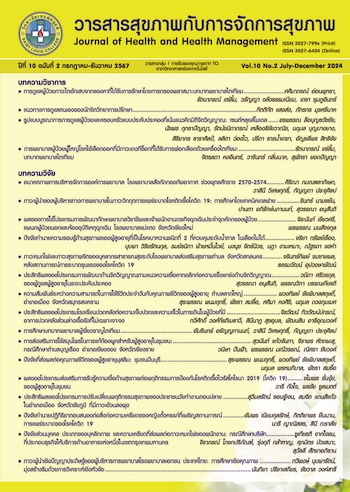A Study of Hemodialysis Specialist Nurse Roles
Keywords:
Hemodialysis specialist nurse, RoleAbstract
The purpose of this descriptive research was to study the role of hemodialysis specialist nurse by using the Delphi technique. Participants were 18 experts. The delphi technique consisted of 3 steps: Step 1: Interview experts about the role of hemodialysis specialist nurse; Step 2: Analyze the data from the interviews and create a questionnaire for the experts to estimate the importance of the role of hemodialysis specialist nurse; and Step 3: Calculate the median and interquartile range from the data from the second round and return the questionnaire to the same group of experts to confirm their answers. The data was then used to calculate the median and interquartile range again to summarize the role of hemodialysis specialist nurse. The results of the research found that: The role of the hemodialysis specialist nurse consists of 6 roles as follows: 1) The role of hemodialysis nurse practice 40 items; 2) The role of education and consultation 11 items; 3) The role of coordination and communication 7 items; 4) The role of safety and risk management manager, 10 items; 5) The role of developer of nursing quality in caring for hemodialysis patients, 12 item and 6) The role of innovation and technology initiator, 7 items. From this research, it was found that Hemodialysis specialist nurse should have roles in all 6 areas as mentioned above to serve as a guideline for nursing administrators in determining roles that are consistent with the expertise of Hemodialysis specialist nurse and as a guideline for the further development of Hemodialysis specialist nurse.
References
กมลทิพย์ วิจิตรสุนทรกุล. (2565). ระบาดวิทยาและการทบทวนมาตรการป้องกันโรคไตเรื้อรัง. กองโรค ไม่ติดต่อ กรมควบคุมโรค กระทรวงสาธารณสุข. สืบค้นจาก https://ddc.moph.go.th/uploads/publish/1308820220905025852.pdf
กรมควบคุมโรค กระทรวงสาธารณสุข. (2567). กรมควบคุมโรค รณรงค์ วันไตโลก 2567 ขับเคลื่อนการเพิ่มคุณภาพชีวิตให้ประชาชน มุ่งเน้นการเข้าถึงการบริการที่เท่าเทียม. สืบค้น จาก https://ddc.moph.go.th/brc/news.php?news=41551&deptcode=brc
กัลปังหา โชสิวสกุล และแสงทอง ธีระทองคำ. (2563). การดูแลแบบองค์รวมชนิดประคับประคองในผู้ป่วยโรคไตเรื้อรังระยะท้ายที่รักษาแบบไม่ล้างไต: กรณีศึกษา. วารสารสภาการพยาบาล, 35(4), 5-17.
จิราภรณ์ ชูวงศ์ และเจียมจิต โสภณสุขสถิตย์. (2554). ผลของการให้ความรู้ทางด้านสุขภาพต่อพฤติกรรมการดูแลตนเองของผู้ป่วยไตวายเรื้อรังที่ได้รับการฟอกเลือดด้วยเครื่องไตเทียม. วารสารวิจัยทางวิทยาศาสตร์สุขภาพ, 5(2), 41-50.
จุฬารัตน์ ห้าวหาญ และอรชร อินทองปาน. (2558). การวิจัยและพัฒนารูปแบบการโค้ชเพื่อพัฒนาความสามารถในการปฏิบัติงานด้านการบริการสุขภาพ, วารสารพยาบาลกระทรวงสาธารณสุข, 25(1), 167-177.
ณฐพุฒิ บุญวิสุทธิ์ และขจร ตีรณธนากุล. (2567). ปัญญาประดิษฐ์ในโรคไต : ความก้าวหน้า โอกาส และข้อกังวลในการฟอกเลือดด้วยเครื่องไตเทียม. วารสารสมาคมโรคไตแห่งประเทศไทย, 30(3), 168-184.
บุญใจ ศรีสถิตย์นรากูร. (2553). ระเบียบวิธีการวิจัยทางการพยาบาลศาสตร์ (พิมพ์ครั้งที่ 5). กรุงเทพฯ: โรงพิมพ์แห่งจุฬาลงกรณ์มหาวิทยาลัย.
พัฒธิดา สุภีสุทธิ์. (2550). การบริหารความเสี่ยงในองค์กรพยาบาล โรงพยาบาลชุมชนที่คัดสรร. (การศึกษาค้นคว้าอิสระ ปริญญาพยาบาลศาสตรมหาบัณฑิต). ชลบุรี: มหาวิทยาลัยบูรพา.
รวงทอง เพิ่มจอมมงคล. (2551). การศึกษาสมรรถนะของพยาบาลผู้เชี่ยวชาญไตเทียม (วิทยานิพนธ์ปริญญามหาบัณฑิต). กรุงเทพฯ: จุฬาลงกรณ์มหาวิทยาลัย.
ลัดดาวัลย์ พุทธรักษา, รัชนีภรณ์ ทรัพย์กรานนท์, และประนอม โอทกานนท์. (2559). ปัจจัยสู่ความสำเร็จในการใช้หลักฐานเชิงประจักษ์ทางการพยาบาลของพยาบาลวิชาชีพ. วารสารคณะพยาบาลศาสตร์ มหาวิทยาลัยบูรพา, 24(3), 94-103.
วัลลีรัตน์ พบคีรี, ศศิธร ดีคล้าย, และสมชาติ โตรักษา. (2564). การพัฒนารูปแบบการดำเนินงานพัฒนางานตามภารกิจหลักสู่งานวิจัย ของฝ่ายการพยาบาล โรงพยาบาลจุฬาภรณ์. วารสารสถาบันบำราศนราดูร, 15(3), 162-171.
ศันสนีย์ รุ่งรัตน์ธวัชชัย. (2554). การบริหารความเสี่ยงสำหรับพยาบาล. กรงเทพฯ: วิทยาลัยพยาบาลและสุขภาพ มหาวิทยาลัยราชภัฏสวนสุนันทา.
สภาการพยาบาล. (2561). ประกาศสภาการพยาบาลเรื่องนโยบายสภาการพยาบาลเกี่ยวกับกำลังคนในทีมการพยาบาล. สืบค้นจาก https://www.tnmc.or.th/images/userfiles/files/003(1).pdf
สภาการพยาบาล. (2563). ราชกิจจานุเบกษา ข้อบังคับสภาการพยาบาล ว่าด้วยข้อจำกัดและเงื่อนไขในการประกอบวิชาชีพการพยาบาลและการผดุงครรภ์ (ฉบับที่ 6) พ.ศ. 2563. (ด้านการบำบัดทดแทนไต (การล้างไตทางช่องท้อง). สืบค้นจาก https://www.tnmc.or.th›news
สมาคมโรคไตแห่งประเทศไทย. (2557). เกณฑ์การตรวจรับรองมาตรฐานการรักษาโดยการฟอกเลือดด้วยเครื่องไตเทียม ฉบับปรับปรุงปี 2557 แพทย์สภา. นนทบุรี: สหมิตรพริ้นติ้งแอนด์พับลิสซิ่ง.
สมาคมโรคไตแห่งประเทศไทย. (2565). ข้อแนะนำเวชปฏิบัติ การฟอกเลือดด้วยเครื่องไตเทียม พ.ศ. 2565 (พิมพ์ครั้งที่ 1). กรุงเทพฯ: เท็กซ์ แอนด์เจอร์นัล พับลิเคชั่น.
สมาคมพยาบาลโรคไตแห่งประเทศไทย (2566). ข้อแนะนำการปฏิบัติการดูแลผู้ป่วยฟอกเลือดและผู้ป่วยล้างไตทางช่องท้อง (พิมพ์ครั้งที่ 1). กรุงเทพฯ: สำนักพิมพ์กรุงเทพเวชสาร.
สมาคมโรคไตแห่งประเทศไทย. (2566). ตำราโรคไตเรื้อรัง เล่ม 2 . (พิมพ์ครั้งที่ 3). กรุงเทพฯ: เท็ก แอนด์ เจอร์นัล พับลิเคชั่น จำกัด.
อัจฉรี คมกฤษ, และอารีย์วรรณ อ่วมตานี. (2564). การศึกษาบทบาทของพยาบาลผู้ประสานงานทางคลินิค. วารสารพยาบาลทหารบก, 22(2), 149-158.
อรนุช ท้าวอนนท์, ไพรินทร ยอดสุบัน, และเรืองอุไร อมรไชย. (2566). การพัฒนาแนวปฏิบัติการพยาบาลผู้ป่วยโรคไตวายเรื้อรังที่ฟอกเลือดด้วยเครื่องไตเทียม. วารสารกองการพยาบาล, 50(3), 185-200.
Bednarski, D., & Painter, D. (2023). American Nephrology Nurses Association Revised Position Statements: ‘The Role of the Registered Nurse in Nephrology’and ‘Delegation of Nursing Care Activities’. Nephrology Nursing Journal, 50(1). doi: 10.37526/1526-744X.2023.50.1.23
Bonner, A. (2007). Understanding the role of knowledge in the practice of expert nephrology nurses in Australia. Nursing & Health Sciences, 9(3), 161-167.
Jónsdóttir, A. A., & Lazo, G. R. (2022). Nephrology Nurses’ Perspectives for the Designs of Mobile Hemodialysis Devices: A Human Factors Engineering Approach. Nephrology Nursing Journal, 49(6), 481-530.
Junior colleges associations committee on research and development. Ca: Monterey.
Linstone, H. A., & Turoff, M. (Eds.). (1975). The delphi method (pp. 3-12). Reading, MA: Addison-Wesley.
Macmillan, T.T. (1971). The delphi technique. Paper presented at the annual meeting of the California
Maria, S., Marie, R., & Debbie, F. (2018). The profile of nephrology nursing. Switzerland: EDTNA/ERCA.
Metzger, M., Yoder, J., Fitzgibbon, K., Blackhall, L., & Abdel-Rahman, E. (2021). Nephrology and palliative care collaboration in the care of patients with advanced kidney disease: Results of a clinician Survey. Kidney medicine, 3(3), 368-377.
Mimura, N., Takuwa, Y., Tamura, Y., Kawamura, H., Nishimura, M., & Yamaguchi, N. (2023). Sustainable development goals in nephrology nursing to support social development for Japan’s changing population: recommendations for a new paradigm. Renal Replacement Therapy, 9(1), 27. doi: 10.1186/s41100-023-00483-2
Ng, M. S. N., Brown, E. A., Cheung, M., Figueiredo, A. E., Hurst, H., King, J. M., ... & Bennett, P. N. (2023). The Role of Nephrology Nurses in Symptom Management–Reflections on the Kidney Disease: Improving Global Outcomes Controversies Conference on Symptom- Based Complications in Dialysis Care. Kidney International Reports, 8(10), 1903-1906.
N. J., Castner, D., Hain, D. J., Latham, C., & Cahill, M. (2022). Nephrology Nursing Scope and Standards of Practice: Take Pride in Practice. Nephrology Nursing Journal, 49(4), 313-327. doi: 10.37526/1526-744X.2022.49.4.313
Rocha, M. T. F. B., Oliveira, C. M. D., Fecury, A. A., Dendacsk, C., Dias, C. A. G. M., & Oliveira, E. D. (2017). The role of nursing in the hemodialysis session. Multidisciplinary Scientific Journal, 2(11), 39-52.
Downloads
Published
How to Cite
Issue
Section
License
Copyright (c) 2024 Journal of health and health management

This work is licensed under a Creative Commons Attribution-NonCommercial-NoDerivatives 4.0 International License.




